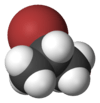2-Bromopropane
| 2-Bromopropane | |
|---|---|
 | |
 | |
 |
 |
| 2-Bromopropane[1] | |
| Other names Isopropyl bromide[2] | |
| Identifiers | |
| CAS number | 75-26-3 |
| PubChem | 6358 |
| ChemSpider | 6118 |
| EC number | 200-855-1 |
| UN number | 2344 |
| MeSH | 2-bromopropane |
| ChEMBL | CHEMBL451810 |
| RTECS number | TX4111000 |
| Beilstein Reference | 741852 |
| Jmol-3D images | Image 1 |
| |
| |
| Properties | |
| Molecular formula | C3H7Br |
| Molar mass | 122.99 g mol−1 |
| Appearance | Colorless liquid |
| Density | 1.31 g mL−1 |
| Melting point | −89.0 °C; −128.1 °F; 184.2 K |
| Boiling point | 59 to 61 °C; 138 to 142 °F; 332 to 334 K |
| Solubility in water | 3.2 g L−1 (at 20 °C) |
| log P | 2.136 |
| Vapor pressure | 32 kPa (at 20 °C) |
| kH | 1.0 μmol Pa−1 mol−1 |
| Refractive index (nD) | 1.4251 |
| Viscosity | 4.894 mPa s (at 20 °C) |
| Thermochemistry | |
| Std enthalpy of formation ΔfH |
−129 kJ mol−1 |
| Std enthalpy of combustion ΔcH |
−2.0537–−2.0501 MJ mol−1 |
| Specific heat capacity, C | 135.6 J K mol−1 |
| Hazards | |
| GHS pictograms |   |
| GHS signal word | DANGER |
| GHS hazard statements | H225, H360, H373 |
| GHS precautionary statements | P210, P308+313 |
| EU classification | |
| R-phrases | R60, R11, R48/20, R66 |
| S-phrases | S16, S45 |
| NFPA 704 |
 3
2
0
|
| Flash point | 19 °C; 66 °F; 292 K |
| Related compounds | |
| Related alkanes | |
| Except where noted otherwise, data are given for materials in their standard state (at 25 °C (77 °F), 100 kPa) | |
| Infobox references | |
2-Bromopropane, also known as isopropyl bromide and 2-propyl bromide, is the halogenated hydrocarbon with the formula CH3CHBrCH3. It is a colorless liquid. It is used for introducing the isopropyl functional group in organic synthesis. 2-Bromopropane is prepared by heating isopropanol with hydrobromic acid.[3]
Preparation
2-Bromopropane is commercially available. It may be prepared in the ordinary manner of alkyl bromides, by reacting isopropanol with phosphorus and bromine,[4] or with phosphorus tribromide.[5]
Reactions
The bromine atom is at the secondary position, which allows the molecule to undergo dehydrohalogenation easily to give propene, which escapes as a gas. Consequently, this reagent is used in conjunction with mild bases, such as potassium carbonate, rather than strong ones.
Safety
Alkylating agents are often carcinogenic.
Further reading
- M G. Gergel “Excuse Me Sir, Would You Like to Buy a Kilo of Isopropyl Bromide?” Pierce Chemical Co. (1979). (story of start-up chemical company).
References
- ↑ "2-bromopropane - Compound Summary". PubChem Compound. USA: National Center for Biotechnology Information. 27 March 2005. Identification. Retrieved 15 June 2012.
- ↑ Wilfred L.F. Armarego and Christina Li Lin Chai, Purification of laboratory chemicals, 7th edition, Butterworth-Heinemann, 2013, p. 176
- ↑ Merck Index of Chemicals and Drugs, 9th ed. Monograph 5071
- ↑ Oliver Kamm and C. S. Marvel (1941), "Alkyl and alkylene bromides", Org. Synth.; Coll. Vol. 1: 25
- ↑ C. R. Noller and R. Dinsmore (1943), "Isobutyl bromide", Org. Synth.; Coll. Vol. 2: 358